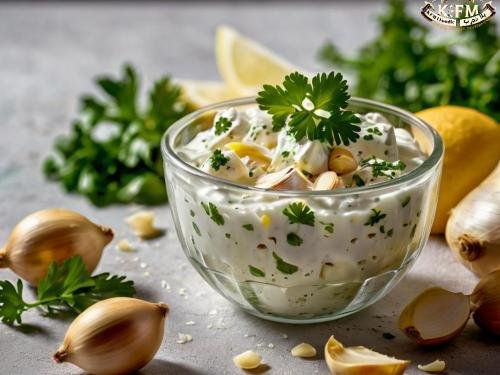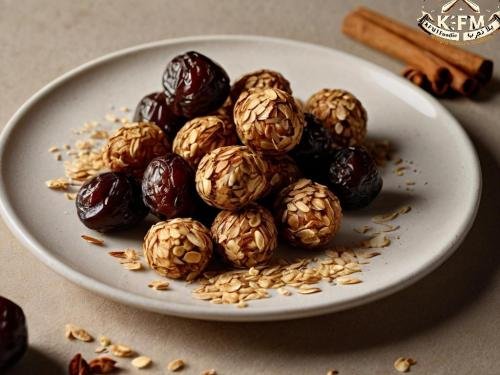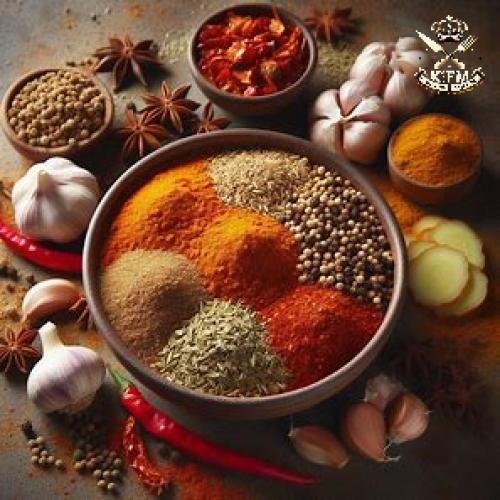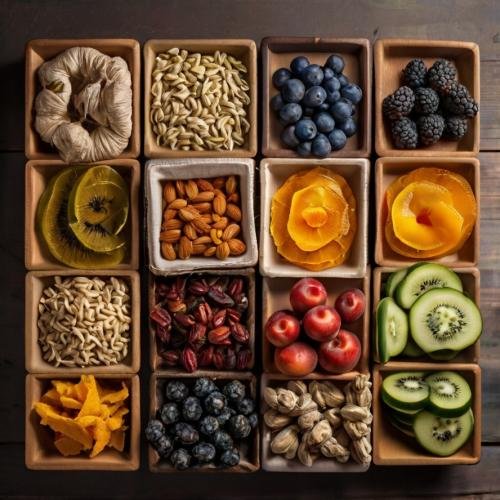Seafood is one of the most nutritious foods that the body needs during Ramadan, as it contains Omega-3 fatty acids that support heart and brain health, in addition to high-quality proteins that help build muscles and regenerate cells. Fish, shrimp, and squid also provide essential nutrients such as zinc, selenium, and vitamin D, which boost immunity and strengthen bones. However, fried seafood should be consumed in moderation to avoid excess calories and unhealthy oils.
Variety of Seafood Iftar Recipes:
1. Creamy Seafood Soup
Ingredients:
- 250g peeled shrimp
- 150g squid, cut into rings
- 100g crab, cut into pieces
- 1 cup cooking cream
- 2 cups fish broth
- 1 tbsp butter
- 1 onion, chopped
- 2 cloves garlic, minced
- Salt and white pepper
- 1 tsp paprika
- Juice of half a lemon
Preparation Method:
Preparing the Ingredients:
- Peel the shrimp, remove the head and shell, and wash it well.
- Clean the squid and cut it into medium-sized rings.
- Wash the crab thoroughly and cut it into halves.
- Finely chop the onion and garlic and prepare the fish broth in advance.
Sautéing the Onion and Garlic:
- In a deep pot, melt two tablespoons of butter over medium heat.
- Add the chopped onion and sauté until translucent, then add the minced garlic and stir for a minute until fragrant.
Adding the Seafood:
- Place the shrimp, squid, and crab in the pot and stir for 3-5 minutes until their color changes.
Adding the Liquid:
- Pour the hot fish broth over the ingredients and bring to a boil.
- Reduce the heat and let the soup simmer for 10 minutes until the flavors blend.
Adding the Cream and Spices:
- Add one cup of heavy cream and mix well.
- Season with salt, black pepper, paprika, and a pinch of nutmeg to taste.
- Let the soup simmer over low heat for 5-7 minutes until it thickens.
Final Touches:
- Add the juice of half a lemon just before serving for a refreshing taste.
- Garnish with chopped parsley or celery as desired.
Serving:
- Pour the hot soup into serving bowls.
- Serve with toasted bread or garlic bread for an enhanced flavor.
Tip: For a deeper taste, you can add a little saffron or chili pepper as desired. 😋
2. Grilled Shrimp with Garlic and Lemon
Ingredients:
- 500g large shrimp
- 2 tbsp olive oil
- 3 cloves garlic, minced
- 1 tsp paprika
- Juice of 1 lemon
- Salt and pepper to taste
Preparation:
Marinade Preparation:
- In a medium-sized bowl, mix 3 tablespoons of olive oil with 4 cloves of mashed garlic.
- Add 1 teaspoon of smoked paprika, 1 teaspoon of salt, ½ teaspoon of black pepper, and 3 tablespoons of fresh lemon juice.
- Stir well until all ingredients are combined.
Marinating the Shrimp:
- Wash 500g of shrimp thoroughly and pat dry with a paper towel.
- Place the shrimp in a deep bowl and pour the marinade over it, ensuring all shrimp are well coated.
- Let the shrimp marinate in the refrigerator for 30 minutes to absorb the flavors.
Preparing the Grill:
- Preheat the grill to medium-high heat. You can use a charcoal grill, gas grill, or a grill pan on the stove.
- Lightly grease the grill with oil to prevent the shrimp from sticking.
Grilling the Shrimp:
- Place the shrimp on the hot grill and cook for 2-3 minutes on each side until it turns pink and firms up.
- Avoid flipping the shrimp multiple times to retain its natural juices.
Serving:
- Remove the shrimp from the grill and arrange it on a serving plate.
- Garnish with fresh lemon slices and chopped parsley. Serve hot with white rice, toasted bread, or a side salad.
Tip: For extra flavor, drizzle 1 teaspoon of melted butter over the shrimp after grilling to enhance juiciness and tenderness. 😋🔥
3. Grilled Singari Fish in the Oven
Ingredients:
- 1 large mullet fish (or any fish of your choice)
- 1 medium onion, finely chopped
- 1 green bell pepper, diced
- 1 red bell pepper, diced
- 1 tomato, finely chopped
- 2 garlic cloves, minced
- 1 tsp cumin
- 1 tsp dried coriander
- ½ tsp salt (or to taste)
- ½ tsp black pepper
- ½ tsp paprika
- 2 tbsp olive oil
- Juice of 1 lemon
- Lemon slices for garnish
Preparation:
✅ Preparing the Fish:
- Wash the fish thoroughly with water, salt, and vinegar, then rinse with cold water.
- Using a sharp knife, cut the fish open from the back and remove the guts.
- Rinse it well inside and out, then pat dry with kitchen towels.
- Make shallow cuts on the skin to help absorb the marinade.
✅ Making the Stuffing:
- In a medium bowl, mix the chopped onion, green and red bell peppers, tomato, garlic, cumin, dried coriander, salt, black pepper, and paprika.
- Add the olive oil and lemon juice, then mix well to combine the flavors.
✅ Stuffing the Fish:
- Place the fish on a baking tray lined with parchment paper or lightly greased with oil.
- Use a spoon to stuff the entire fish cavity with the prepared vegetable and spice mixture.
- Place lemon slices on top for extra flavor and a refreshing touch.
✅ Baking the Fish:
- Preheat the oven to 200°C (392°F).
- Put the tray in the oven and bake for 25-30 minutes until the fish is fully cooked and turns golden.
- For a crispy surface, turn on the broiler for the last 5 minutes.
✅ Serving:
- Remove the fish from the oven and let it rest for 5 minutes before serving.
- Serve hot with white rice or tahini salad and traditional bread.
Tip: For a stronger flavor, marinate the fish for 30 minutes before baking.
4. Boiled Crab with Lemon and Garlic
Ingredients:
- 2 medium-sized crabs
- 3 cloves garlic, minced
- 2 bay leaves
- 1 teaspoon cumin
- Juice of 1 lemon
- Salt to taste
Preparation Method:
Preparing the Ingredients:
- Clean the crabs thoroughly by washing them with cold water and scrubbing the outer shell with a brush to remove any impurities.
- Remove the gills and inedible parts using kitchen scissors if needed.
Boiling the Water:
- In a large pot, add enough water to fully submerge the crabs.
- Place the pot over high heat until the water starts boiling.
Adding the Spices:
- Once the water boils, add bay leaves, cumin, and a tablespoon of salt.
- You can also add whole garlic cloves to enhance the flavor.
Cooking the Crab:
- Carefully place the crabs into the boiling water using tongs or a large spoon.
- Partially cover the pot and let the crabs cook for 15-20 minutes or until their shells turn a light orange color.
- Use a fork or knife to check if the meat is tender and easy to cut.
Preparing the Seasoning:
- In a small bowl, mix the juice of one lemon with two finely minced garlic cloves.
- You can add a little olive oil or melted butter for extra flavor.
Serving:
- Once cooked, drain the crabs and place them on a serving plate.
- Drizzle the lemon-garlic mixture over the hot crabs to absorb the flavors.
- Serve with garlic sauce or any preferred seafood dip.
Tip:
For a richer taste, you can roast the boiled crabs in the oven for 5 minutes with a little butter and garlic before serving.
5. Crispy Fried Squid
Ingredients:
- 500g squid, cut into rings
- 1 cup all-purpose flour
- 1 teaspoon paprika
- 1 teaspoon salt
- 1/2 teaspoon black pepper
- 1/2 teaspoon garlic powder (optional)
- 1/2 teaspoon chili powder (optional)
- 1 cup cold water or milk (for extra crispiness)
- Oil for frying
Preparation:
Preparing the Squid:
- Wash the squid thoroughly with cold water and vinegar to remove any fishy smell.
- Pat dry using paper towels.
Preparing the Coating Mixture:
- In a deep bowl, mix the flour with paprika, salt, black pepper, garlic powder, and chili powder.
Coating the Squid:
- Dip the squid rings into cold water or milk, then coat them evenly with the flour mixture.
- Let them rest for 5 minutes to ensure the coating sticks well.
Frying:
- Heat oil in a deep frying pan to 180°C (350°F).
- Carefully add the squid rings in batches to prevent the oil temperature from dropping.
- Fry for 3-4 minutes until golden and crispy.
- Remove from oil and drain on a paper towel to absorb excess oil.
Serving:
Serve the crispy fried squid hot with tartar sauce, fries, or a side salad.
🔹 Tip: For extra crunchiness, double-coat the squid by dipping it in flour twice.
Healthy Alternatives for Cooking Seafood
Reducing Fat in Recipes:
- Replace heavy cream with low-fat milk or yogurt.
- Use olive oil in moderate amounts instead of butter or hydrogenated oils.
Healthy Cooking Methods:
- It’s best to grill or bake seafood instead of frying.
- An air fryer can be a healthy alternative to reduce fat content.
- Boiling or steaming fish preserves its nutrients without adding extra calories.
Complementary Side Dishes
Delicious Seafood Sauces
- Tahini Sauce: A blend of tahini, lemon juice, mashed garlic, and cumin.
- Garlic and Lemon Sauce: A mix of minced garlic, lemon juice, olive oil, and salt.
Recommended Drinks with Seafood During Ramadan
- Lemon Mint Juice: Helps improve digestion.
- Coconut Water: Hydrates the body after fasting.
- Cold Hibiscus Tea: Balances blood pressure and provides a refreshing feeling.
Nutritional Tips
The Right Amount of Protein from Seafood in Iftar
It is recommended to consume about 100-150 grams of fish or shrimp to ensure sufficient protein intake without excess.
How to Reduce Fish Odor While Cooking
- Soak the fish in lemon juice and vinegar for 10-15 minutes before cooking.
- Add herbs such as rosemary and thyme during cooking to reduce the smell.
- Ensure proper kitchen ventilation while cooking.
Best Spices to Enhance Flavor Without Excess Salt
- Cumin and ground coriander to enhance taste.
- Sweet paprika for a rich flavor.
- Ginger and garlic to add a strong and natural taste without needing much salt.
Frequently Asked Questions About Seafood in Ramadan
Can seafood be eaten daily in Ramadan?
Yes, it can be eaten daily, but it is important to vary between different types such as fish, shrimp, and salmon to gain diverse nutritional benefits while maintaining moderation in quantity.
What types are suitable for people with seafood allergies?
People with seafood allergies are advised to avoid shellfish such as shrimp and crab. They can try white fish like tilapia or grouper after consulting a doctor.
What is the best time to eat seafood during fasting?
It is best consumed at iftar as a light meal or in suhoor in moderate amounts, as proteins help reduce hunger throughout the day.
How can seafood be properly stored to maintain its quality?
- Keep fresh fish in the refrigerator and consume it within 1-2 days.
- Freeze it in vacuum-sealed bags to preserve its flavor and quality for a longer time.
- When cooking, thaw it gradually in the refrigerator rather than at room temperature.
Nutritional Values and Benefits of Each Ingredient:
- Shrimp (per 100g):
- Calories: 99 kcal
- Protein: 24g
- Fat: 0.3g
- Vitamin D: 50% of daily requirement
- Benefits: Rich in protein and low in fat, supports brain health and immunity.
- Squid (per 100g):
- Calories: 92 kcal
- Protein: 16g
- Omega-3: 250 mg
- Benefits: Promotes heart and brain health, low in saturated fat.
- Mullet Fish (per 100g):
- Calories: 120 kcal
- Protein: 20g
- Fat: 4g
- Omega-3: 1.2g
- Benefits: Good for heart and joint health, enhances focus and memory.
- Crab (per 100g):
- Calories: 97 kcal
- Protein: 19g
- Zinc: 45% of daily requirement
- Benefits: Boosts immunity and helps in red blood cell formation.
Health Benefits of Seafood During Ramadan
The Effect of Omega-3 Fatty Acids on the Body
Omega-3 fatty acids are essential for heart and brain health, helping to reduce inflammation, improve brain function, and enhance eye health. They also play a crucial role in supporting the immune system, reducing the risk of chronic diseases.
Boosting Energy During Fasting
Seafood is a rich source of high-quality protein, which helps keep you full for longer. The healthy fats it contains provide sustainable energy during long fasting hours. Minerals such as zinc and iron also play a role in boosting energy levels and reducing fatigue.
Impact on Digestive Health During Ramadan
Seafood is easy to digest and contains healthy fatty acids that support digestive health. When consumed with vegetables, it provides fiber that promotes bowel movement and helps reduce constipation, a common issue during Ramadan.
Enjoy a nutritious and diverse seafood Iftar meal in Ramadan, and share delicious dishes packed with health benefits with your family!




















